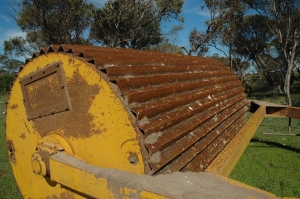
Key Points
- Rolling firms and levels the soil surface after soil renovation – to ensure good sowing depth control and crop establishment.
- There are several types of rollers, each suited to different soils and surface conditions.
- Generally, the deeper the rip, the heavier the roller needed to firm the surface afterwards.
- Rolling can increase erosion risk, and a smooth surface is more prone to erosion than a ridged surface.
- Heavier and more ridged rollers do more damage to stubble.
- It is best to check roller effectiveness during rolling.
Soil amelioration practices like deep ripping leave the soil surface soft and uneven. A weighted roller, either towed behind the ripper or used in a separate pass, can:
- Break up clods brought to the surface during ripping.
- Push rocks back into the soil (so it is better to pick up large rocks before rolling)
- Conserve soil moisture.
- Improve trafficability and flotation of the seeding bar (less sinkage and wheel ruts).
- Firm the surface and reduce inter-row ridges from the tynes before seeding for better sowing depth control and seed-soil contact to improve seed imbibition (water uptake) and germination.
The different types of rollers
Rollers can be classified into five broad types, based on characteristics like width, diameter, weight, material (e.g. steel versus rubber), teeth and alignment.
Each type is designed to achieve a specific result and soil finish depending on soil type, moisture content and stubble levels.
Some are bought ‘off the shelf’, especially those that are built into the ripper and designed to both assist with ripping and soil surface preparation. On the other hand, a lot of independently towed rollers are home made.
Depending on the brand or who you talk to, ‘roller’ and ‘packer’ can be used interchangeably – or even together in the case of a ‘roller-packer’. In this article, ‘packer’ is associated with a coil packer and ‘roller’ is used more generally.
1. Drum roller
In its simplest form, a smooth cylinder like an old piece of pipe. Many are hollow so you can add weight (for example water) to make them heavier. They leave a smoother surface than other rollers. Variations have teeth or bars to help crumble clods and push rocks back into the ground. Home-made options include angle iron welded to large diameter steel pipe, either across the pipe or around it (to leave ridges on the soil surface).
Smooth – when to use it: After sowing peas to remove ridges. Rolling stubble flat for seeding into it. If it is all you have and something is better than nothing.
Ribbed/Ridged/Toothed – when to use it: To break up clods. A toothed roller can smash stubble and leave a pocked surface. For example, a Reefinator is a ribbed roller.
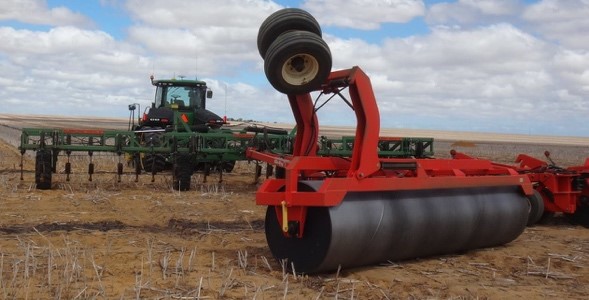
2. Hydraulic cage roller
Hydraulic cage rollers are a cage-type construction which is hollow in the middle. Bars can be parallel to the axle or on a slight angle. Pressure can be adjusted with hydraulics. These types of rollers leave a less ridged surface than a coil packer or spring roller. There can be mixed results if ripping to depths of more than 500mm.
When to use it: When there are clods on surface or in dry, non-sticky soils.
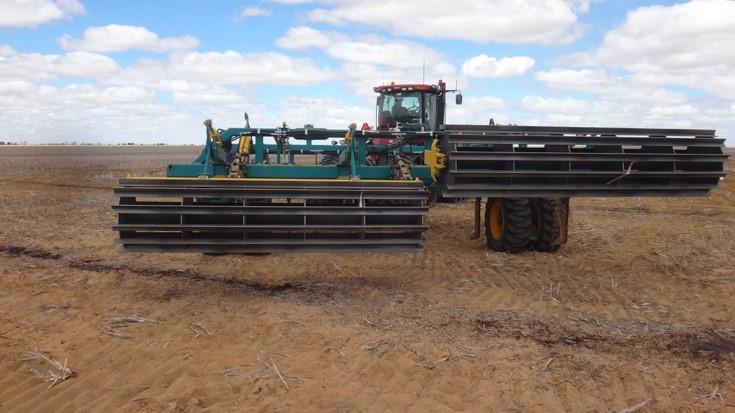
3. Coil packer
A coil packer is one coil on an axle. It leaves a herringbone pattern to control wind and water erosion. It also leaves more stubble than heavier rollers.
When to use it: When you only need a light pack and finish and don’t have clods on the surface. Probably not heavy enough to use after ripping more than 300mm or in damp conditions.
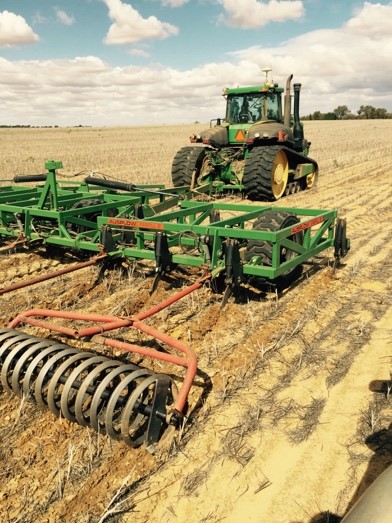
4. Ring rollers
Ring rollers are a series of rings on a single axle. The rings do not move independently (compare with Cambridge roller below.) Variations in ring shape (e.g. U or V) and materials leave a different finish. The rings leave ridges on the surface which help with erosion control and moisture retention. Spring rollers have flex which helps crack clods. Tyre rollers have rubber tyres along the axle.
When to use it: Used on loose sandy soil and sticky ground.
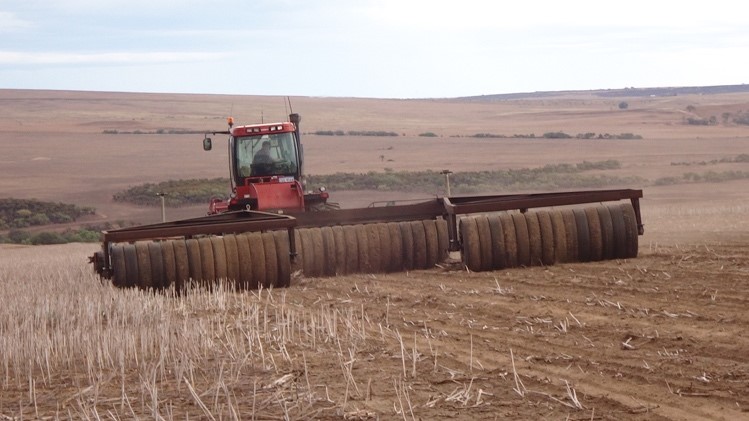
5. Cambridge roller
A Cambridge roller is a series of cast rings on a single axle. Each ring moves independently. It leaves a series of ‘V’ shaped tracks that help with wind and water erosion. Moisture is drawn into the ‘V’. This type of roller is good for working over pugged ground (lumpy ground caused by hooves).
When to use it: Used in undulating terrain or pugged ground.

Which roller is right for you?
The ideal roller varies with soil type and amelioration method. Most growers will compromise and use one roller for all situations. Their ‘right’ roller, therefore, is one that works for most situations on their farm.
Rollers will not miraculously fix the results of poor soil amelioration, such as when clods have been brought to the surface by ripping when the soil is too dry, or if there was very dense subsoil (that may have been best left as a subsoil). In these cases, mixing the soil surface first by ploughing, cultivating and even stubble crunching is usually beneficial.
Growers with clods (or ‘house bricks’) of densely packed sand, need to break them up or they will hinder seeding, establishment and probably herbicide efficacy. Large diameter or flat rollers have more surface area in contact with the soil and consequently less pressure to smash clods. A crumble roller with lots of spikes or narrow diameter bars is best used in this situation – the smaller the surface area, the more the weight of the roller will be concentrated into clod crushing pressure.
The heavier (more clayey) and drier the clods, the harder they will be. It will take more pressure to crush them and, in some cases, growers might even need to break them up first with something like a speed tiller or offset disc.
Rollers will not break most rocks—they will only push them into the ground to reappear during seeding.
Choosing your roller by soil and surface type
On sandier soils, flatter and lighter rollers are effective – such as a coil packer or drum roller with limited ridging/teeth. The exception is on sandy duplex soils where, if you dry and pull up hard clods it can be tricky to crush them. Because the clods are harder than the surface soil, the roller might push them back into the ground instead of breaking them up. The finished surface will look flat but the hidden clods will cause establishment issues and reduced chemical performance. Again, an option is to break up the clods with a speed tiller or offset disc first and, if you can, wait until you have had some rain so the clods are easier to break.
If you have variable paddocks the key trait to look for in a roller is the ability to change pressure. Being able to alter the packing pressure means you can use it on multiple soil types, adjusting as needed. A hydraulic roller, or a drum roller you can fill to control the weight, are both good options. However, adding weight from the ripper frame can cause the tynes to lift up, and you do not rip as deeply. It becomes a balancing act between ripping depth and keeping enough weight on the roller.
Some hydraulic rollers have accumulators on their lift cylinders to ‘float’ the roller, so ripping can be deeper and the roller will not bulldoze the soil.
Where erosion is a concern, consider roller weight and finish. If you have low stubble cover, heavier rollers will do more damage to the standing stubble and increase your erosion risk. With high stubble cover, the roller might just flatten it but leave it intact. If the stubble cover is low in summer/autumn and you rip, don’t use a roller until closer to seeding.
The best soil surface finish is a matter of conjecture. Rollers that leave a smoother finish (such as a drum roller) are generally thought to make the soil more prone to erosion, while rollers that leave ridges or do less damage to the stubble (such as a coil packer) will reduce erosion potential. Specific finishes (for example golf ball dimples, herringbone) are likely to be beneficial for reducing erosion and/or improving water infiltration. Angle iron rolled around a drum roller has been used to make ridges to reduce erosion.
On undulating surfaces, very wide, rigid rollers can result in uneven packing, as the roller won’t always be in contact with the soil along its full length. Cambridge style rollers, where the rings move individually, are better in those conditions.
If the ground is wet, tyre rollers, spring rollers, or a ring roller with a U-shaped profile can work well. If the ripper is leaving wide furrows, you will need a heavy weighted roller. When the ground is loose and dry (with few clods), consider a tyre or drum roller.
Finally, some rollers are simply unsuitable for certain conditions. Bulldozing the soil instead of rolling over it is a clear sign that the roller is either too heavy or too small in diameter. Rollers that are too small will tend to sink in, pushing the soil in front of them and making ridges out to the side. Anecdotally, rollers that are part of the machine are more likely to bulldoze than towed rollers.

There is limited research on the ideal pressures for different soil types and conditions. Anecdotal evidence and current thinking is the more weight the better. So go as heavy as you can, without bulldozing or leaving a lumpy surface.
How do you know if it is working properly?
The only effective way to see how well your roller is working is to get out and check. Signs it is not heavy enough are:
- Clods and rocks still on the surface.
- Clods not being broken up, just pushed under the surface. (You will need to dig behind the roller to check this out.)
- Very uneven surface.
Sometimes you only discover the roller wasn’t heavy enough later. Sinking machinery, using more fuel than expected or pulling clods back to the soil surface are all signs you should have had more pressure.
If your hydraulic roller isn’t working as heavily as you thought it would, check with the manufacturer to make sure the roller is set up correctly. In a recent example, the manufacturer found a critical part of the hydraulics had not been fitted to the machine.
No roller is perfect for every situation, and rollers are not the only way to consolidate soil post-amelioration. Smudge bars, levelling bars, and even shallow cultivation/stubble crunching can break clods when set up correctly and if soil moisture is adequate. However, these methods will not always achieve the right soil strength to reduce seeding problems and crop establishment issues, so rolling afterwards is still likely to be beneficial.
This article was produced as part of the GRDC ‘Maintain the longevity of soils constraints investments and increase grower adoption through extension – western region’ investment.








